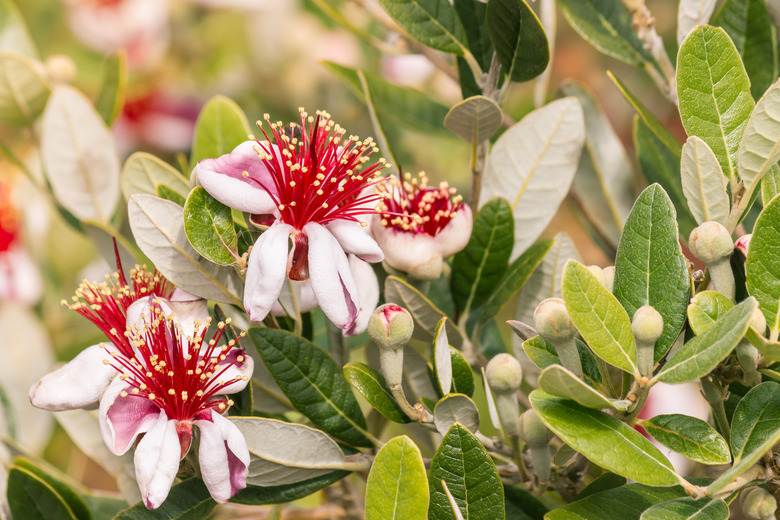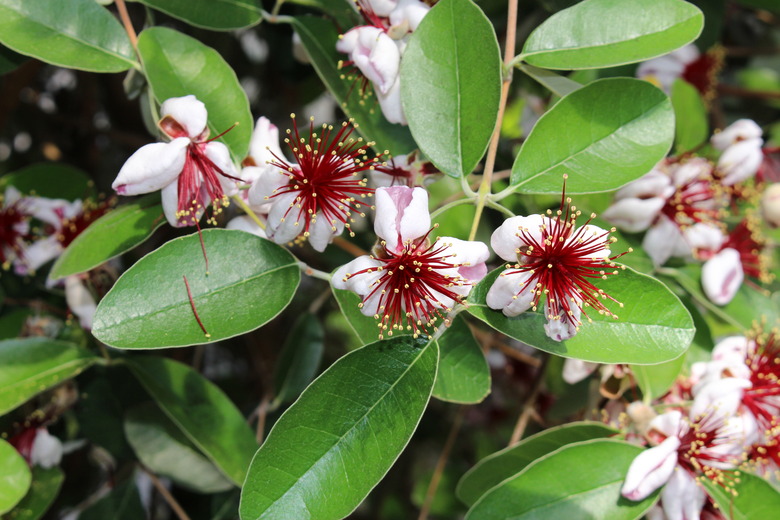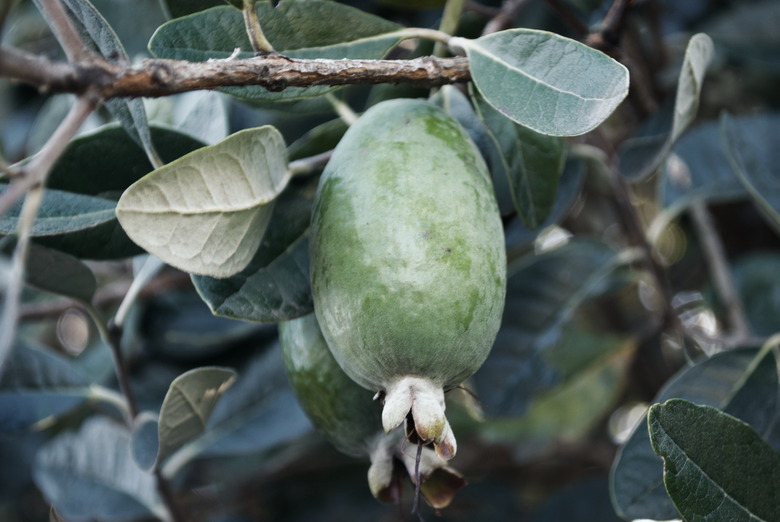How To Grow Pineapple Guava
We may receive a commission on purchases made from links.
Pineapple guava (Acca sellowiana, USDA zones 8-10) was formerly known by the scientific name Feijoa sellowiana, and people who live in its native growing regions, including Brazil, Argentina, Paraguay and other parts of South America, commonly refer to it as feijoa. It's an evergreen shrub that is known for its showy and edible flowers as well as its delicious fruit, and it can serve as an ornamental to bring color to the winter landscape in regions where it grows.
The elliptical leaves are thick and leathery, about 2 to 3 inches long and about an inch wide. The four to six purple-white flower petals frame a cluster of red stamens, each topped by a large grain of yellow flowers. All parts of the flower are edible, and the petals, which are slightly sweet, make a tasty addition to salads. The yellow-tipped stamens attract birds, but bees are the main pollinators, and because cross-pollination is needed to produce the best fruit, it's recommended to grow more than one plant.
The fruit is round to pear-shaped and can range in length from an inch to 3 1/2 inches. It has a waxy skin that can range in color from blue-green to gray with a tinge of red or orange, and inside are 20 to 40 small seeds surrounded by a fragrant, translucent pulp. The pulp, which has a taste similar to pineapples and strawberries, gives the fruit a fragrant aroma, and you can eat it with a spoon, seeds and all. If you're primarily interested in feijoa fruit, two of the best-tasting cultivars are Apollo and Edenvale Improved Coolidge, and 'Mammoth' is the largest.
Best Uses for Pineapple Guava
Best Uses for Pineapple Guava
The pineapple guava bush has something to offer in every season. This low-maintenance member of the Myrtle family (Myrtaceae) responds well to a good pruning and can be trained as an espalier (a plant trained to grow on a flat surface such as a fence or a lattice) or formed into a dense hedge. It makes a good foundation plant, and it's a showy ornamental that you can use for borders or as a feature all by itself. It is winter hardy in USDA hardiness zone 8 and can tolerate temperatures down to 15 degrees Fahrenheit, but it dislikes extremely hot summer temperatures, which can make the fruit drop prematurely, limiting its southerly growing range to zone 10 or 11.
As a fruit tree, pineapple guava can be part of an edible landscape, especially when planted with fig, which is a recommended companion plant. When used as a showy ornamental, it pairs well with mandevilla (a flowering vine) and the flowering shrubs bottlebrush and nandina (also known as heavenly bamboo).
This isn't a plant you want to hide, so it needs a prominent place in the landscape, and when it is given enough space, it can grow into a tree with a height of 15 feet and a spread of 6 feet. Because it produces better fruit when there's another pineapple guava nearby to cross-pollinate it, you might want to consider placing two trees together on either side of the front walkway or on opposite corners of the house. The most efficient use, however, is to plant several side by side to form a hedge.
Starting Pineapple Guava From Seed
Starting Pineapple Guava From Seed
Pineapple guava is easy to start from seed, which you obtain by squeezing the pulp into a container and letting it stand for four days to ferment. You then strain out the seeds and dry them. When you're ready to plant, prepare a pot with soil starter mix, moisten the soil and sow the seeds from 1 to 1 1/2 inches deep.
It's essential to keep the seeds warm for successful germination, so use a heat mat for 24 hours a day or grow lights for 14 hours a day and keep the soil moist. Germination takes about three weeks, and when the seedlings emerge, you can transfer each to its own container. Keep the new plants indoors for two to three months before transplanting them outdoors.
Starting Pineapple Guava From a Seedling
Starting Pineapple Guava From a Seedling
Choose a sunny location that is protected from direct wind and prepare the soil for your seedlings by turning in well-rotted compost. Dig a hole for each plant that is about 1 1/2 times as wide and just as deep as the root ball. Set the plant in the hole, spread out the roots and backfill with the excavated soil. Then, water to get rid of air bubbles and fertilize with a high-phosphorous fertilizer.
Space the seedlings 10 to 15 feet apart if you are growing them as trees and as close as 5 feet apart when planting hedge rows. If you're using pineapple guava as a foundation plant, you can reduce the spacing even further to 3 feet.
In What Zone Does Pineapple Guava Grow Best?
In What Zone Does Pineapple Guava Grow Best?
Pineapple guava is primarily a warm-weather plant, but it can tolerate temperatures as low as 15 degrees, and in fact, it produces better fruit when exposed to cold temperatures. It grows best in locations with cool winters and moderate summers with temperatures ranging between 80 and 90 degrees, and while it needs a steady supply of water for good fruit production, it's drought-tolerant and will survive in a dry climate. It's an ideal plant for the entire West Coast, the East Coast as far north as Virginia and the central states as far north as Missouri.
When Should You Plant Pineapple Guava?
When Should You Plant Pineapple Guava?
Because pineapple guava is more tolerant of cold than heat, you can plant it in the fall in areas without harsh winters. In areas with freezing temperatures, it should go in the ground as soon as possible after the last spring frost to give it time to get established before the hot weather arrives.
Soil, Sunlight and Water Recommendations for Pineapple Guava
Soil, Sunlight and Water Recommendations for Pineapple Guava
Poor soil isn't a big problem for pineapple guava, but if you want the plant to be happy and produce abundantly, the soil should be sandy loam with a high concentration of nutrients. The plant will grow in clay as long as the soil doesn't get saturated in the winter. Young pineapple guava plants need regular watering, but they become more drought-tolerant as they mature, and mature plants may not need much more water than what is provided by the rain.
Soil should be slightly acidic to neutral with a pH between 5.5 and 7.0. If the soil is too alkaline, the plant can't absorb phosphorous, which affects chlorophyll production, and the leaves turn yellow. The leaves also need plenty of sunlight, so the plants should be in full sun. Plants will tolerate partial shade, but fruit production will suffer.
How to Propagate Pineapple Guava
How to Propagate Pineapple Guava
You can propagate pineapple guava through seeds, cuttings, grafts and by layering. Seeds need to be dried before planting or storing them, and they will keep for a year in a dry location. The best cuttings are taken from young wood; they can be treated with a rooting hormone and planted directly in the ground or kept warm and misted in a greenhouse until they sprout roots, which takes about two months.
How to Harvest Pineapple Guava
How to Harvest Pineapple Guava
You don't harvest pineapple guava so much as you catch it when it falls. If you can't wait, you can pick fruit when it's soft and let it ripen on your kitchen counter, which is fine if you're planning to turn it into a jam or a smoothie. If you want to spoon out the pulp and eat it fresh, though, the best-tasting pineapple guavas are the ones that ripen on the tree.
Large-scale growers usually put nets under the trees and shake the trees to dislodge the fruit, which ripens four-and-a-half to seven months after the flowers appear. The nets prevent bruising, which doesn't affect the taste but makes the fruit less marketable.
Common Pests and Other Problems for Pineapple Guava
Common Pests and Other Problems for Pineapple Guava
Very few pests bother pineapple guava. Perhaps the only insects attracted to the plant besides bees are fruit flies, which tend to congregate around ripe and overripe fruit with a pungent odor. The flies lay their eggs underneath the skin of the fruit, and the larvae eat the pulp and cause the fruit to rot.
You can avoid a fruit fly infestation by picking fruit before it is fully ripe and assiduously keeping the ground clear of fallen fruit. You can also trap fruit flies by putting a banana in a jar and covering the opening with a paper funnel that points into the jar. The flies, attracted by the banana, can easily get into the jar, but they can't get out.
A third way to deal with fruit flies is to spray them, using a commercial spray to kill them.
Common Diseases for Pineapple Guava
Common Diseases for Pineapple Guava
Pineapple guava is just as resistant to diseases as it is unattractive to pests, and few bother it consistently, although there are two for which to watch:
Cercospora leaf spot is a fungal disease that causes brown spots on the leaves. The spots gradually widen until they have a gray coloration in the center and a brownish tinge on the edges. This disease rarely does permanent damage to the plant, but if enough leaves are affected and fall off, growth may be stunted.
Cleanliness is the best defense. The fungus lives in old leaves and other debris lying around the base of the plant, so remove these often and pull affected leaves off the plant. If the disease is advanced, you may need to treat the plant with a fungicide, and because the fungus can attack new leaves as they emerge, repeated applications may be necessary.
Downy mildew, also known as sooty mold, can affect plants when conditions are extremely humid. It leaves a grayish deposit on the underside of the leaves, and in severe cases, the fruit can be infected. The best defense against this pathogen is to prevent it by watering moderately and using mulch to retain soil moisture. You can treat severe cases with a fungicide.


